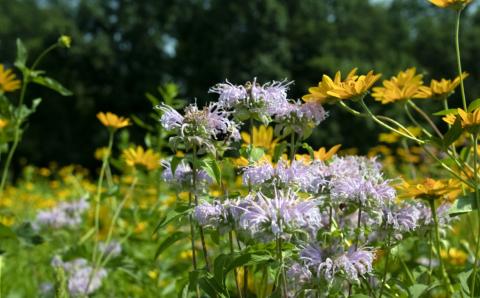The Beauty of Meadow Wildflowers
Meadow wildflowers are nature's masterpiece, painting landscapes with vibrant colors and intricate designs. These flowers, thriving in open fields and grasslands, offer a glimpse into the diversity and resilience of plant life. Their beauty not only pleases the eye but also supports a myriad of ecosystems.
This article explores the enchanting world of meadow wildflowers, their ecological significance, the variety of species, and how to cultivate them in your garden.
The Ecological Significance of Meadow Wildflowers
 Meadow wildflowers play a crucial role in maintaining ecological balance. They provide habitat and food for a wide range of wildlife, including insects, birds, and mammals.
Meadow wildflowers play a crucial role in maintaining ecological balance. They provide habitat and food for a wide range of wildlife, including insects, birds, and mammals.
Pollinators like bees and butterflies rely on these flowers for nectar, which in turn supports the pollination of many other plants.
Biodiversity and Ecosystem Health
Wildflower meadows are hotspots of biodiversity. The presence of various flower species promotes a healthy ecosystem by supporting diverse insect populations, which serve as food for birds and small mammals.
This biodiversity ensures that the ecosystem remains resilient to changes and can recover from disturbances.
Soil Health and Water Management
The root systems of meadow wildflowers contribute to soil health by preventing erosion and improving soil structure. Their deep roots help to retain moisture, reduce runoff, and enhance the soil's ability to absorb water.
This natural water management system is essential for maintaining the health of the meadow and surrounding areas.
The Diversity of Meadow Wildflowers

The variety of wildflowers in meadows is astonishing, with each species contributing its unique charm. From the delicate petals of the buttercup to the bold hues of the cornflower, each flower adds a different stroke to the meadow's canvas.
Common Meadow Wildflower Species
- Buttercup (Ranunculus spp.): Known for their bright yellow petals, buttercups are a common sight in many meadows.
- Cornflower (Centaurea cyanus): These striking blue flowers stand out and attract numerous pollinators.
- Oxeye Daisy (Leucanthemum vulgare): With their classic white petals and yellow centers, oxeye daisies are a quintessential meadow flower.
- Red Clover (Trifolium pratense): This flower not only adds a splash of color but also enriches the soil by fixing nitrogen.
Seasonal Blooms and Visual Impact
Meadow wildflowers bloom in different seasons, ensuring that the meadow is always adorned with flowers. Spring brings the first flush of color with species like primroses and violets. Summer sees a riot of colors from species such as poppies and foxgloves, while autumn is marked by the blooms of asters and goldenrods. This succession of blooms provides continuous visual interest and supports wildlife throughout the growing season.
Cultivating Meadow Wildflowers in Your Garden
Bringing the beauty of meadow wildflowers into your garden can be a rewarding experience. It involves selecting the right species, preparing the soil, and maintaining the meadow to ensure it thrives.
Choosing the Right Species
Selecting native wildflower species is crucial for creating a successful meadow. Native plants are adapted to the local climate and soil conditions, making them more resilient and easier to grow.
Research which wildflowers are native to your region and choose a mix that will provide blooms throughout the growing season.
Soil Preparation and Planting
Proper soil preparation is essential for establishing a wildflower meadow. Start by removing existing vegetation and preparing the soil by tilling and adding organic matter if needed.
Wildflower seeds can be sown directly onto the prepared soil, either by hand or using a seed spreader. Ensure good seed-to-soil contact by lightly pressing the seeds into the soil.
Maintenance and Management
Once established, a wildflower meadow requires minimal maintenance. Regular mowing in the first year helps to control weeds and encourage the growth of wildflowers.
In subsequent years, mowing once or twice a year after the flowers have set seed will help maintain the meadow's health.
Avoid using pesticides and herbicides, as they can harm the beneficial insects and plants that make up the meadow ecosystem.
Conclusion
Meadow wildflowers are not only a feast for the eyes but also vital components of our ecosystems. They support biodiversity, improve soil health, and offer seasonal beauty that changes throughout the year. By understanding their ecological significance and learning how to cultivate them, you can bring the splendor of meadow wildflowers into your own garden. Embrace the natural elegance of these flowers and contribute to the preservation of our environment.

























































